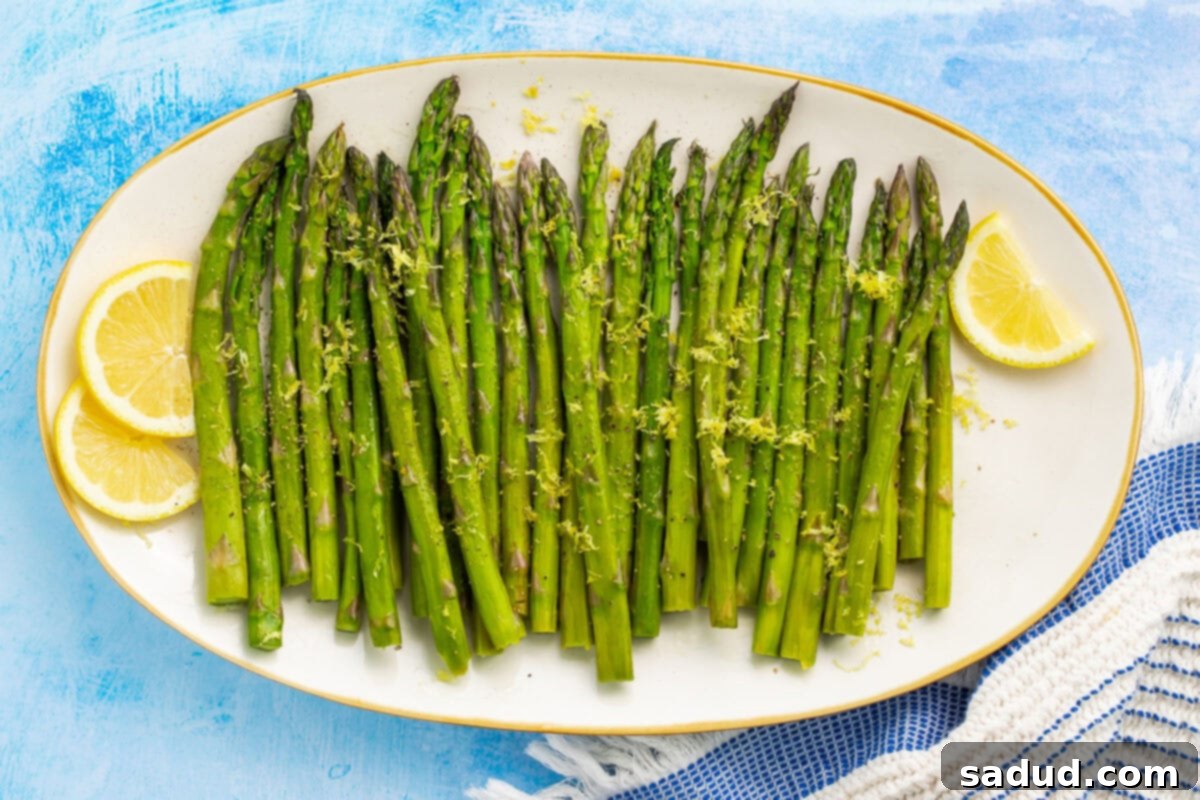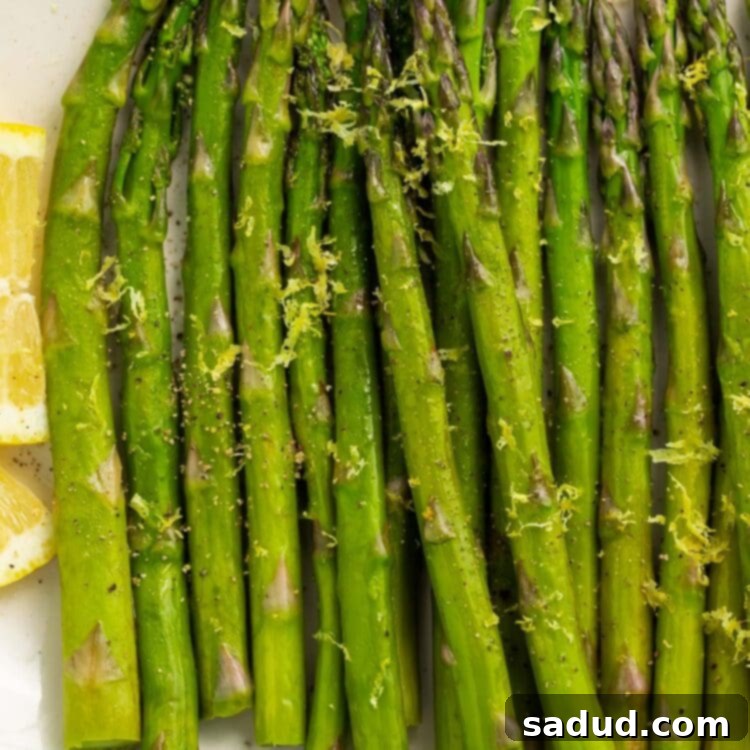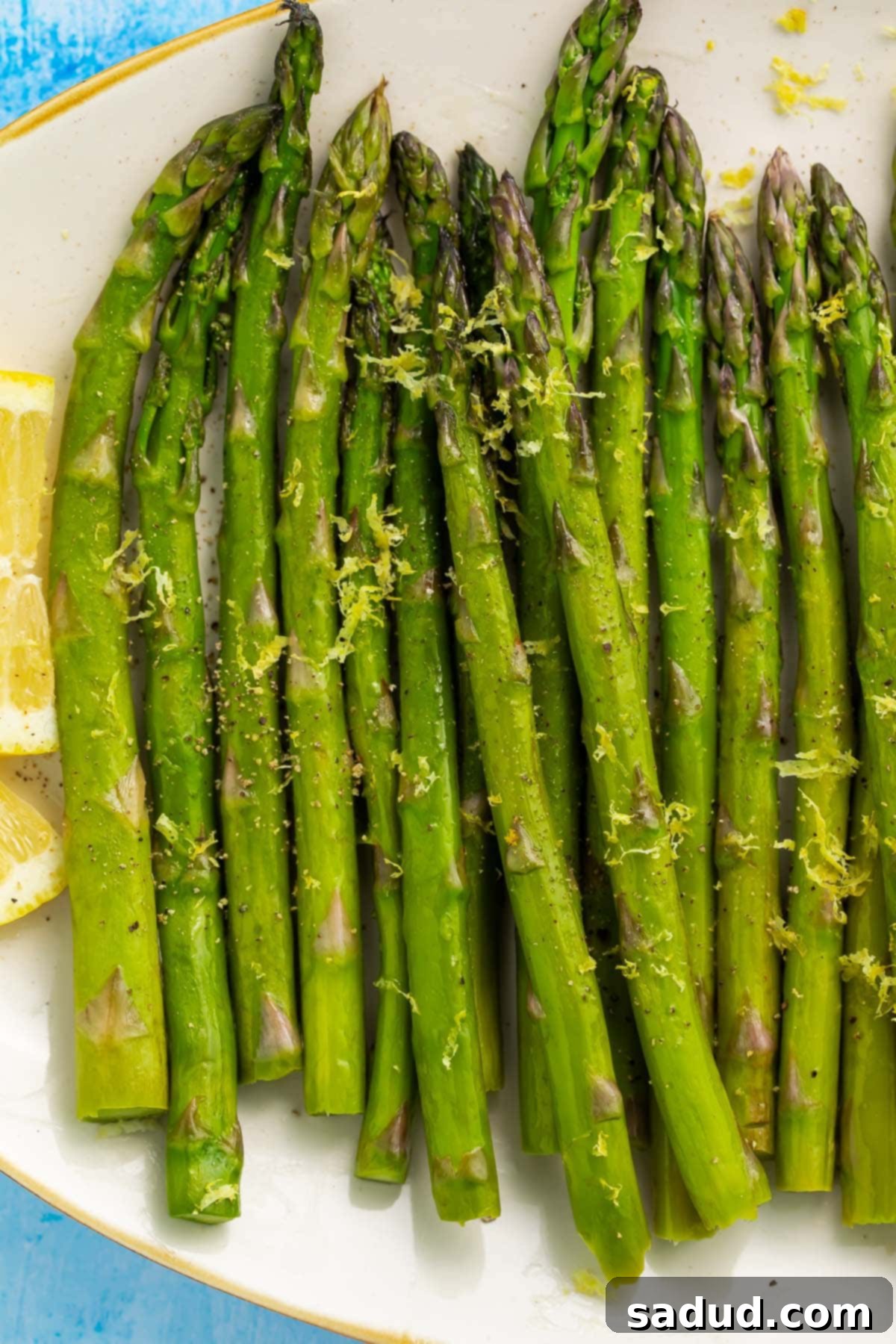Perfectly Tender Sous Vide Asparagus: The Easiest Way to Cook a Springtime Favorite
Discover the secret to flawlessly cooked, perfectly tender asparagus every single time with this incredibly simple sous vide recipe. If you’ve struggled with overcooked or mushy asparagus in the past, or simply want a hands-off method that guarantees delicious results, then sous vide cooking is your answer. This innovative technique uses a temperature-controlled water bath to gently cook asparagus to its ideal crisp-tender perfection, enhancing its natural sweetness and vibrant green color. Requiring minimal effort and ready to impress in just 15 minutes, this recipe is set to become your go-to for preparing this delightful springtime vegetable.

Why Sous Vide Asparagus is a Game Changer
There’s a lot to love about cooking asparagus using the sous vide method. It takes all the guesswork out of achieving perfectly cooked vegetables, making it ideal for both novice cooks and seasoned chefs alike. Here are the top reasons why this technique stands out:
-
Effortless Perfection Every Time: The primary advantage of sous vide cooking is its unparalleled precision. By immersing your food in a precisely temperature-controlled water bath, you eliminate the risk of overcooking. Asparagus emerges consistently tender, never mushy, with a delightful bite and vibrant hue. This hands-off approach means you can set it and forget it, freeing up your attention for other parts of your meal. While commonly used for proteins like chicken breast, prime rib, or brisket, the sous vide machine truly shines with delicate vegetables like asparagus and potatoes, ensuring they reach their peak texture without constant monitoring.
-
Unleash Your Creativity with Seasonings: Sous vide asparagus is incredibly versatile when it comes to flavor profiles. While a simple combination of salt, pepper, and butter highlights the asparagus’s natural taste beautifully, the sealed bag provides an excellent environment for infusing other flavors. Consider adding crushed garlic cloves for a pungent kick, a sprig of fresh rosemary or thyme for an herbaceous aroma, or a dash of lemon-garlic seasoning for a bright, zesty note. Instead of just lemon zest, try finishing your dish with a generous dusting of freshly grated Parmesan cheese, a sprinkle of red pepper flakes for a touch of heat, or even a drizzle of balsamic glaze for a sweet and tangy twist. The possibilities are endless, allowing you to tailor this side dish to complement any main course.
-
Retains Nutrients and Vibrant Color: Unlike boiling or steaming, which can leach out water-soluble vitamins and dull the color of vegetables, sous vide cooking locks in nutrients and maintains the asparagus’s striking green. The gentle, even heat ensures that every spear cooks uniformly, resulting in a visually appealing and healthier side dish.
-
Ideal for Meal Prep: Sous vide asparagus can be cooked ahead of time, chilled, and then quickly reheated. This makes it an excellent option for meal prepping healthy sides for the week or for effortlessly preparing a component of a larger holiday meal. Simply plunge the sealed, cooked bag back into a warm water bath for a few minutes to bring it back to serving temperature.
Expert Tips for Perfect Sous Vide Asparagus
Achieving restaurant-quality sous vide asparagus is simple with a few key considerations. Follow these tips to ensure your asparagus turns out perfectly tender and flavorful every single time:
-
Ensure Full Submergence: This is arguably the most critical tip for any sous vide cooking. For the asparagus to cook evenly and thoroughly, it must be entirely submerged in the temperature-controlled water bath for the duration of the cooking time. Any portion of the food that floats above the waterline will not cook properly, resulting in inconsistent textures. If your bag tends to float, use sous vide weights, heavy ceramic plates, sturdy metal clips attached to the pot, or even clean silverware placed inside the bag (if space allows and it won’t puncture the bag) to weigh it down. The goal is to keep all the asparagus spears fully immersed in the circulating water.
-
Sort Asparagus by Thickness: Asparagus spears can vary significantly in thickness, even within the same bunch. Since cooking time is directly correlated with the thickness of the vegetable, it’s highly recommended to separate your asparagus into different bags based on their size. This allows you to cook very thin spears for a shorter duration (e.g., 8 minutes) while thicker spears can continue cooking for an additional 2-4 minutes (e.g., 10-12 minutes) to reach the same ideal tenderness. This extra step ensures uniform results across your entire batch, preventing thinner spears from becoming overcooked and mushy while thicker ones are still tough.
-
Trim Properly: Before cooking, make sure to trim the woody ends off your asparagus. You can do this by holding a spear and bending it until the natural breaking point, or by simply cutting off the bottom 1-2 inches. This ensures that every bite is tender and palatable.
-
Choosing the Right Bag: You can use either a dedicated vacuum-sealer bag with a vacuum sealer or a high-quality, food-safe zipper-top plastic bag (like Ziploc freezer bags). If using a zipper-top bag, employ the water displacement method to remove as much air as possible before sealing. This method involves slowly lowering the open bag into the water bath, allowing the water pressure to push out the air, then sealing the bag just above the waterline.
-
Don’t Crowd the Bag: While you can cook a good amount of asparagus in one bag, avoid overcrowding it. Lay the asparagus spears in a single layer or in a loose bundle to ensure even heat distribution around all the vegetables. If you have a very large quantity, consider using multiple bags.
-
Ice Bath for Stopping the Cook (Optional): If you plan to cook the asparagus ahead of time for meal prep, plunge the sealed bag into an ice bath immediately after removing it from the sous vide. This rapidly chills the asparagus, stopping the cooking process and preserving its crisp texture and vibrant color. Store chilled asparagus in the fridge for up to 3-4 days.

More Incredible Asparagus Recipes
While sous vide offers a superior way to cook asparagus, this versatile vegetable shines in many other preparations. Explore these delicious alternatives and expand your asparagus repertoire:
- Smoked Asparagus
- Bacon Wrapped Asparagus with Garlic Aioli
- Potato Asparagus Soup
- Instant Pot Asparagus
- Cheesy Roasted Asparagus
- Truffle Honey Chicken with Asparagus
- Asparagus Salad
- Air Fryer Asparagus

Sous Vide Asparagus Recipe
15 minutes
8-12 minutes
23-27 minutes

Cheryl Malik
Print
Save
Saved!
Ingredients
For the Asparagus
- 1 bunch fresh asparagus trimmed, approximately 1 pound, ideally sorted by thickness
- ½ teaspoon salt or more, to taste
- ¼ teaspoon freshly cracked black pepper or more, to taste
- 3 tablespoons unsalted butter cut into multiple small pieces for even distribution
Serving Suggestions (All Optional)
- 1 tablespoon fresh lemon zest from approximately 1 medium lemon
- Lemon wedges for squeezing
- Freshly grated Parmesan cheese
- Red pepper flakes
Equipment
-
Large pot or other large, heat-resistant container deep enough for the immersion circulator
-
Sous vide immersion circulator
-
Large food-safe vacuum sealing bag or large sealable food-safe plastic bag (e.g., Ziploc freezer bag)
-
Vacuum sealer optional, see Notes for alternative water displacement method
-
Sous vide weights (optional) or heavy kitchen item to keep bag submerged
Instructions
-
1. Prepare Water Bath: Fill a large pot or other large, heat-resistant container with water. Ensure the pot is deep enough for your sous vide immersion circulator to operate with the water level falling between its minimum and maximum indicators. Insert the circulator and set the temperature to 180° Fahrenheit (82°C). Allow the water to reach the target temperature.
-
2. Season Asparagus: Take your trimmed 1 bunch fresh asparagus and place it into a large, food-safe sealable bag. Add ½ teaspoon salt and ¼ teaspoon freshly cracked black pepper evenly over the spears. Distribute the 3 tablespoons unsalted butter (cut into smaller pieces) among the asparagus spears within the bag. If cooking different thicknesses of asparagus, divide them into separate bags and season each bag accordingly.
-
3. Seal the Bag: Remove as much air as possible from the bag. If you have a vacuum sealer, use it to create a tight seal. If using a zipper-top bag, employ the water displacement method (see Notes below for detailed instructions) to push out the air. Ensure the bag is completely and securely sealed to prevent water from entering during cooking.
-
4. Cook in Water Bath: Once the water bath reaches 180°F, carefully place the sealed bag of asparagus into the preheated water. Make absolutely sure that all the asparagus spears are fully submerged in the water. If the bag floats, use appropriate weights (as detailed in the Tips section and Notes) to keep it underwater.
-
5. Timing the Cook: Cook the asparagus according to the thickness of the spears:
- 8 minutes for very thin spears.
- 10 minutes for average thickness spears.
- 12 minutes for very thick spears.
Adjust cooking times if you prefer a slightly softer or firmer texture.
-
6. Finish and Serve: After the appropriate cooking time, carefully remove the bag from the water bath. Give the bag a gentle shake or massage to thoroughly coat the asparagus spears in the melted butter and seasonings. Open the bag and transfer the perfectly cooked asparagus to serving plates or a platter. Garnish with 1 tablespoon fresh lemon zest and lemon wedges for a bright finish, if desired. Serve immediately and enjoy the tender, flavorful results!
Notes
- Vacuum Sealer Alternative (Water Displacement Method): If you don’t own a vacuum sealer, you can effectively remove air using the water displacement method. Place your seasoned asparagus in a high-quality, food-safe zipper-top plastic bag (like a Ziploc freezer bag). Leave the bag mostly unzipped, sealing only an inch or two at one corner. Slowly lower the bag into the heated water bath, allowing the water pressure to push the air out through the unsealed portion. You’ll notice the plastic clinging tightly to the food as the air escapes. Once the asparagus is fully submerged and all the air has been expelled, carefully seal the remaining portion of the bag completely while it’s still mostly submerged. Then, proceed with the rest of the recipe.
- Preventing Floating Asparagus: It is paramount that your asparagus remains fully submerged to cook correctly. If the bag tries to float, you can use specialized sous vide weights, heavy-duty clips to attach the bag to the side of the pot (ensuring the asparagus stays below the water line), or even a heavy ceramic plate or bowl placed on top of the bag. Pie weights, if you have them in a heat-safe container, can also work.
- Asparagus Quality: Always choose fresh asparagus with firm, brightly colored spears and tight, closed tips. Thinner spears tend to be more tender, while thicker ones can be meatier. Both cook beautifully sous vide, just remember to adjust cooking times.
- Flavor Variations: Beyond the basic salt, pepper, and butter, consider adding other aromatics to the bag:
- Herbs: Fresh dill, tarragon, or a bay leaf.
- Garlic: Thinly sliced garlic cloves or a touch of garlic powder.
- Spicy: A pinch of red pepper flakes.
- Citrus: A slice of lemon or orange in the bag.
- Savory: A tiny splash of soy sauce or a sprinkle of nutritional yeast for a cheesy flavor.
- Storage and Reheating: Cooked sous vide asparagus can be stored in an airtight container in the refrigerator for up to 3-4 days. To reheat, you can gently warm it in a pan with a little butter, or for best results, place it back into a 180°F (82°C) sous vide bath for 5-7 minutes until heated through.
Nutrition Information
Serving:
1
serving
|
Calories:
99
kcal
|
Protein:
3
g
|
Fat:
9
g
|
Saturated Fat:
5
g
|
Trans Fat:
0.3
g
|
Total Carbs:
5
g
|
Fiber:
3
g
|
Sugar:
2
g
|
Net Carbs:
2
g
|
Vitamin C:
8
mg
|
Cholesterol:
23
mg
|
Sodium:
294
mg
|
Potassium:
234
mg
|
Calcium:
32
mg
|
Iron:
2
mg
Number of total servings shown is approximate. Actual number of servings will depend on your preferred portion sizes.
Nutritional values shown are general guidelines and reflect information for 1 serving using the ingredients listed, not including any optional ingredients. Actual macros may vary slightly depending on specific brands and types of ingredients used.
To determine the weight of one serving, prepare the recipe as instructed. Weigh the finished recipe, then divide the weight of the finished recipe (not including the weight of the container the food is in) by the desired number of servings. The result will be the weight of one serving.
Cheryl Malik
We hope this guide inspires you to try cooking asparagus the sous vide way! The ease and consistent perfection of this method make it truly unmatched. We are confident you’ll be delighted by the incredibly tender and flavorful results.
If you loved this recipe as much as we did, don’t forget to leave us a review below and tell us about your experience! ★
Follow Easy Healthy Recipes on Pinterest, Facebook, and Instagram to stay updated with our latest delicious recipes and cooking tips!
For more delicious recipes, visit our sister sites, 40 Aprons and Easy Cheap Recipes.
